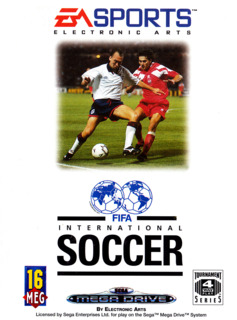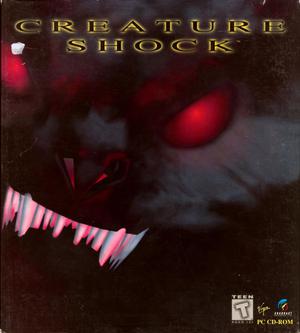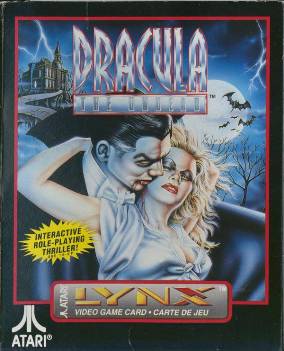
The Atari Jaguar is a home video game console developed by Atari Corporation and released in North America in November 1993. Part of the fifth generation of video game consoles, it competed with the 16-bit Sega Genesis, the Super NES and the 32-bit 3DO Interactive Multiplayer that launched the same year. Powered by two custom 32-bit processors – Tom and Jerry – in addition to a Motorola 68000, Atari marketed it as the world's first 64-bit game system, emphasizing its 64-bit bus used by the blitter, however, none of its three CPUs had a 64-bit instruction set in the same way as later 64-bit consoles such as the PlayStation 2 or Nintendo 64. The Jaguar launched with Cybermorph as the pack-in game, which received divisive reviews. The system's library ultimately comprised only 50 licensed games.

The Nintendo 64 (N64) is a home video game console developed and marketed by Nintendo. It was released in Japan on June 23, 1996, in North America on September 29, 1996, and in Europe and Australia on March 1, 1997. The successor to the Super Nintendo Entertainment System, it was the last major home console to use cartridges as its primary storage format until the Nintendo Switch in 2017. As a fifth-generation console, the Nintendo 64 primarily competed with Sony's PlayStation and the Sega Saturn.

The Neo Geo CD is a home video game console produced by SNK Corporation, released on September 9, 1994. The system is the same platform as the cartridge-based Neo Geo released four years earlier, but converted to the cheaper CD media format which retailed at $49 to 79 per title compared to over $200 for the equivalent cartridge.

The PlayStation is a home video game console developed and marketed by Sony Computer Entertainment. It was released in Japan on 3 December 1994, in North America on 9 September 1995, in Europe on 29 September 1995, and in Australia on 15 November 1995. As a fifth-generation console, the PlayStation primarily competed with the Nintendo 64 and the Sega Saturn.

The 32X is an add-on for the Sega Genesis video game console. Codenamed "Project Mars", it was designed to expand the power of the Genesis and serve as a transitional console into the 32-bit era until the release of the Sega Saturn. The 32X uses its own ROM cartridges and has its own library of games. It was distributed under the name Super 32X in Japan and South Korea, Genesis 32X in North America, Mega 32X in Brazil, and Mega Drive 32X in all other regions.

3DO is a video gaming hardware format developed by The 3DO Company and conceived by entrepreneur and Electronic Arts founder Trip Hawkins. The specifications were originally designed by Dave Needle and RJ Mical of New Technology Group, and were licensed by third parties; most hardware were packaged as home video game consoles under the name Interactive Multiplayer, and Panasonic produced the first models in 1993 with further renditions released afterwards by manufacturers GoldStar, Sanyo, Creative Labs, and Samsung Electronics.
The fifth generation era refers to computer and video games, video game consoles, and handheld gaming consoles dating from approximately October 4, 1993, to March 23, 2006. The best-selling home console was the Sony PlayStation, followed by the Nintendo 64 and Sega Saturn. The PlayStation also had a redesigned version, the PSone, which was launched on July 7, 2000.

Pinball Fantasies is a 1992 pinball video game originally developed by Digital Illusions and published by 21st Century Entertainment in Europe for the Amiga home computers. It is the sequel to Pinball Dreams, which was released earlier in the same year on multiple platforms. In the game, players can choose between any of the four available playfields, both of which have their own thematic and main objectives in order to obtain the highest score possible.

The Humans is a puzzle-platform video game developed by Imagitec Design in Dewsbury, England and originally published by Mirage Technologies for the Amiga in May 1992. It was later ported to other home computers and consoles. The goal of the game varies per level but usually revolves around bringing at least one of the player-controlled humans to the designated end area marked by a colored tile. Doing this requires players taking advantage of the tribe's ability to build a human ladder and use tools such as spears, torches, wheels, ropes and a witch doctor in later levels.

FIFA International Soccer is a 1993 association football video game developed by EA Canada's Extended Play Productions team and published by Electronic Arts. The game was released for the Sega Mega Drive/Genesis console in December 1993 and ported to numerous other systems in 1994. It is the first game in the FIFA series.

Soulstar is a hybrid rail shooter/third-person shooter video game developed and published by Core Design for the Sega CD in North America in September 1994, Europe in October by Core Design, and in Japan by Victor Entertainment on December 22.

Defender 2000 is a 1996 scrolling shooter video game developed by Llamasoft and published by Atari Corporation for the Atari Jaguar. Part of Atari's 2000 series of arcade game revivals, it is an update of Eugene Jarvis' arcade game Defender (1981). The premise takes place in a future where the Alpha Promixian empire attack mining settlements on distant resource planets. Gameplay is divided into three modes, with the player acting as part of the System Defense Team commanding the Threshold ship to defeat waves of invading aliens while protecting humans.

Worms is a 2D artillery tactical video game developed by Team17 and released in 1995. It is the first game in the Worms series of video games. It is a turn based game where a player controls a team of worms against other teams of worms that are controlled by a computer or human opponent. The aim is to use various weapons to kill the worms on the other teams and have the last surviving worm(s).

Brett Hull Hockey is an ice hockey video game developed by Radical Entertainment and originally published by Accolade for the Super Nintendo Entertainment System in North America in January 1994. It prominently features former Canadian-American NHL player Brett Hull and is officially licensed from the NHL Players' Association.

Creature Shock is a 1994 sci-fi game released for MS-DOS and 3DO. It was developed by Argonaut Software and published by Virgin Interactive Entertainment. The game was later ported to the CD-i, Sega Saturn and PlayStation video game systems.

Dracula - The Undead is a video game released in 1991 for the Atari Lynx handheld system. The game is loosely based on Bram Stoker's novel Dracula and features Bram Stoker in the story as the narrator.

The Super NES CD-ROM is an unreleased add-on for the Super Nintendo Entertainment System (SNES) video game console. It was built upon the functionality of the cartridge-based SNES by adding support for a CD-ROM-based format known as Super Disc.

Nintendo 64 Game Pak is the brand name of the ROM cartridges that store game data for the Nintendo 64. As with Nintendo's previous consoles, the Game Pak's design strategy was intended to achieve maximal read speed and lower console manufacturing costs through not integrating a mechanical drive, with a drawback of lower per dollar storage capacity compared to a disk. From the console's first year from late 1996 through 1997, Game Pak sizes were 4 to 12 megabytes with a typical third party retail price of US$75.99, then available in 32 megabytes in 1998, and finally 64 megabytes from 1999 onwards.
Legions of the Undead is an unreleased action role-playing video game that was in development by Rebellion Developments and originally planned to be published by Atari Corporation on a scheduled Q3, 1995 release date for the Atari Jaguar. It was also intended to be released for the Windows and PlayStation.



















